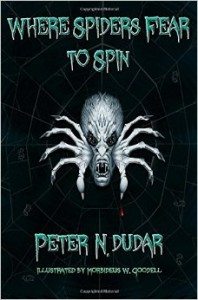
Peter N. Dudar
Books & Boos Press (Hebron CT)
2015
Reviewed by Michael R. Collings
Peter N. Dudar’s novella, Where Spiders Fear to Spin—in this volume coupled with a highly effective short story, “Peripheral Vision”—offers intriguing insights on life, death, and the often permeable boundary between them; on love and hate and the difficulty in distinguishing them; on loss and grief and the ways they can distort human perceptions and emotions; and most of all, on ghosts. Both the novella and the story are quintessential ghost stories, but readers would do well not to expect traditional wispy, moaning, transparently ectoplasmic presences, because in these tales, ghosts can kill.
Where Spiders Fear to Spin has as principle characters four individuals tied by bonds of love and hate and fear: Sadie Mills, an aging soap-opera star now dying slowly and painfully, who had been fully as promiscuous as the wealthy woman she portrayed on Forbidden Steam; Theresa Mills, her daughter, who, as she approaches an unfulfilled mid-life, is torn between hatred for the woman she now must nurse and love for the memory of her dead father; Andy Mills, twenty years dead and now returned as a grotesque, monstrous ghost dedicated to revenge; and… a spider, patiently spinning her complex web in the rafters of the sickroom.
Lest anyone be tempted to conjure images of Charlotte’s Web (as the characters in fact do), this spider is a creature driven by instinct and dread, concerned solely with her survival and that of the eggs she carries within her. Initially, she seems almost peripheral to the central story, but in Dudar’s adept hands, she becomes an instrument of retribution in a most startling and appropriate way—in essence, a symbolic and literal force for justice and balance.
From the utter nastiness of the opening scene between Sadie of the Soaps and her bitter, vindictive daughter, to the final glimpse of Sadie entering a Hell beyond her worst imagining, Dudar tests the limits of family, depicting two utterly self-centered women whose lives focus more on the dead than on the living. Sadie is obsessed with her dead career; and Theresa, with her dead father, killed in car wreck. The women quarrel incessantly, about everything, each trying to score a point on the other. When Andy’s ghost appears, mother and daughter must confront realities rather than dreams—and the process nearly destroys them both.
“Peripheral Vision” amplifies on the themes of obsessive love and obsessive guilt as Theodore Danvers begins seeing the ghost of his dead son…but in this story indirectly, a momentary blur in the corner of his eye. He relates his haunting to Sister Margaret Willis, a church bereavement councilor; and readers immediately become enmeshed in the growth of his self-reproach, his isolation, and ultimately his self-destructive madness. It is a powerful story, to be sure, but not a pretty one.
The novella and the accompanying short story can be read in a single sitting, which intensifies the incremental tensions as Dudar raises questions of whether mutual understanding, acceptance, and forgiveness are possible, for either the living or the dead. His ghosts are real, his supernatural intrusions treated matter-of-factly; even the nameless spider perceives Andy’s ghostly presence and is terrified by it. This method of treatment gives both Where Spiders Fear to Spin and “Peripheral Vision” a kind of hardness, an oddly fitting definiteness, a sense of the uncompromising nature of the dead who can reach from the Beyond and force their wills upon mortals.








